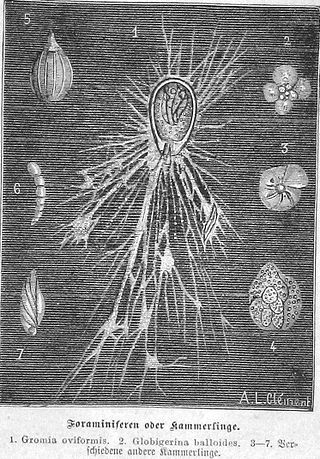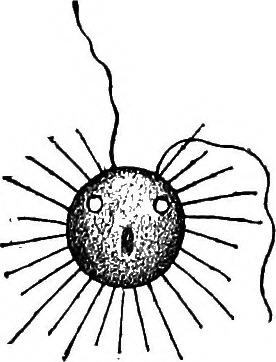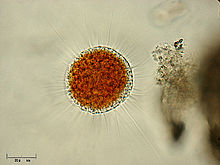
The family Vampyrellidae is a subgroup of the order Vampyrellida within the supergroup Rhizaria. Based on molecular sequence data, the family currently comprises the genus Vampyrella, and maybe several other vampyrellid amoebae. The cells are naked and characterised by radiating, filose pseudopodia and an orange colouration of the main cell body.

The Heliomonadida are a small group of heliozoan amoeboids that are unusual in possessing flagella throughout their life cycle.

Cercozoa is a phylum of diverse single-celled eukaryotes. They lack shared morphological characteristics at the microscopic level, and are instead united by molecular phylogenies of rRNA and actin or polyubiquitin. They were the first major eukaryotic group to be recognized mainly through molecular phylogenies. They are the natural predators of many species of bacteria. They are closely related to the phylum Retaria, comprising amoeboids that usually have complex shells, and together form a supergroup called Rhizaria.

The Rhizaria are a diverse and species-rich supergroup of mostly unicellular eukaryotes. Except for the Chlorarachniophytes and three species in the genus Paulinella in the phylum Cercozoa, they are all non-photosynthethic, but many foraminifera and radiolaria have a symbiotic relationship with unicellular algae. A multicellular form, Guttulinopsis vulgaris, a cellular slime mold, has been described. This group was used by Cavalier-Smith in 2002, although the term "Rhizaria" had been long used for clades within the currently recognized taxon. Being described mainly from rDNA sequences, they vary considerably in form, having no clear morphological distinctive characters (synapomorphies), but for the most part they are amoeboids with filose, reticulose, or microtubule-supported pseudopods. In the absence of an apomorphy, the group is ill-defined, and its composition has been very fluid. Some Rhizaria possess mineral exoskeletons, which are in different clades within Rhizaria made out of opal, celestite, or calcite. Certain species can attain sizes of more than a centimeter with some species being able to form cylindrical colonies approximately 1 cm in diameter and greater than 1 m in length. They feed by capturing and engulfing prey with the extensions of their pseudopodia; forms that are symbiotic with unicellular algae contribute significantly to the total primary production of the ocean.

The Phytomyxea are a class of parasites that are cosmopolitan, obligate biotrophic protist parasites of plants, diatoms, oomycetes and brown algae. They are divided into the orders Plasmodiophorida and Phagomyxida. Plasmodiophorids are best known as pathogens or vectors for viruses of arable crops.
Gymnophryidae is a small family of amoeboids that lack shells and produce thin, reticulose pseudopods. These contain microtubules and have a granular appearance, owing to the presence of extrusomes, but are distinct from the pseudopods of Foraminifera. They are included among the Cercozoa, but differ from other cercozoans in having mitochondria with flat cristae, rather than tubular cristae.
Reticulosida is an order of Cercozoa that was created by Cavalier-Smith in 2003, but subsequently emended in by Bass et al. in 2009 to include only one monotypic family, the Filoretidae.

Monadofilosa is a grouping of Cercozoa. These organisms are single-celled amoeboid protists.

Retaria is a clade within the supergroup Rhizaria containing the Foraminifera and the Radiolaria. In 2019, the Retaria were recognized as a basal Rhizaria group, as sister of the Cercozoa.

Endomyxa is a group of eukaryotic organisms in the supergroup Rhizaria. They were initially a subphylum of Cercozoa and later a subphylum of Retaria, but several analyses have proven they are a phylogenetically separate lineage, and Endomyxa is currently regarded as its own phylum.
Heliomorpha is a genus of Cercozoa, placed in its own family, Heliomorphidae. It used to be known as "Dimorpha", but that name was a junior synonym several times over.

The sarcomonads or class Sarcomonadea are a group of amoeboid biciliate protists in the phylum Cercozoa. They are characterized by a propensity to move through gliding on their posterior cilium or through filopodia, a lack of scales or external theca, a soft cell surface without obvious cortical filamentous or membranous skeleton, two cilia without scales or hairs, tubular mitochondrial cristae, near-spherical extrusomes, and a microbody attached to the nucleus.
Borkovia is a genus of Cercozoa.

Gromiida is an order of cercozoans. It is the only order in the class Gromiidea.

Granofilosea is a class of cercozoan protists in the subphylum Reticulofilosa. Out of the three groups that were traditionally considered heliozoans: the heliomonads, gymnosphaerids and desmothoracids, the latter were recently grouped into this new class.
Leucodictyids are heterotrophic amoeboid protists that comprise the order Leucodictyida in the phylum Cercozoa.

Acinetactis is a possible genus of protist first described in 1886 by A.C. Stokes, who also described the type species A. mirabilis. In 1928, Valkanov reported the discovery of a second species, A. arnaudovii. The most recently recorded specimen of A. mirabilis was reported in 1940, no Acinetactis specimens have been reported since.
Nanofila is a genus of marine heterotrophic protists of the phylum Cercozoa. It is the only genus in the family Nanofilidae. It is a monotypic genus, with the sole species N. marina.
Cryptofilida is an order of small heterotrophic protists in the phylum Cercozoa. They are filose amoebae that lack cilia and gliding, and are instead characterized by movement through branching or unbranched granular filopodia that are appressed to the substrate during their feeding.
Mesofila is a genus of freshwater heterotrophic protists of the phylum Cercozoa. It is the only genus in the family Mesofilidae. It is a monotypic genus, with the sole species M. limnetica.








